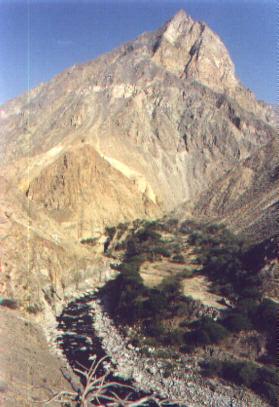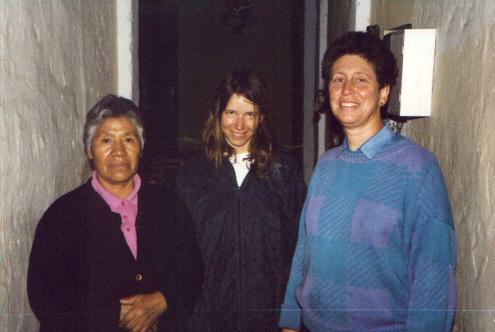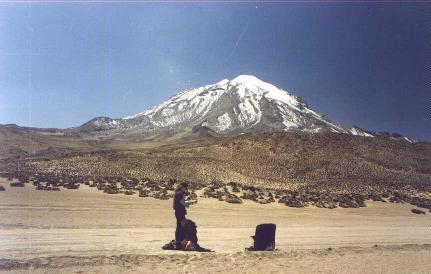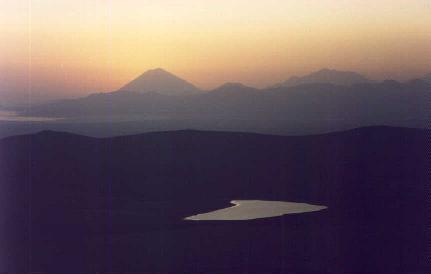
The Colca river.
One cannot tell how relieved we were at the sight of our tent... we felt like coming back home....
The next morning we went down. One more day, at about 2 O'clock we were back in civilisation (If one can call a tiny village of 50 people and with only 2 hours a day a generator-made electricity). The village of Parinacota is 5 K.M. from the main road, where we hoped to find a lift. As there was an organised group of about 8 tourists around, we thought "why walk if we can try to get a lift from them ?". Their driver apologised a lot while explaining - "We don't go directly to Arica. We are a one day tour and this village is our first stop. If you want to continue with us till Arica, you will have to go with us first to lake Chungara, then to stop for a lunch break in Putre, and only then, at about 20 O'clock we will arrive to Arica"
And that was how we not only got a lift, but an organised free tour as well...
In Arica we took a day rest (= supermarkets, markets) and then - back to Peru to the second largest town - Arequipa, and the adjacent famous active snow-capped Vulcan "El Misti" at 5,912 meters.
In Bolivia and Chile it is common that in the beginning of an intercity bus-ride, a man gets on the bus and tries to sell something. "Something" can be from classic books through medical herbs to chocolates. In this bus ride to Arequipa, a man got in the bus and started to talk about the young Peruvian generation. He talked from a philosophic point of view, about the difficulties that the youth has to confront with, like the urbanisation, unemployment and crime. He talked about the loss of ideals of the youth of today (which is not like in the past...) and continued on and on... (for something like half an hour). I was quite fascinated - the man talked very well, and I thought that maybe he studied retorics (the speech theory). I tried to figure out what kind of item he would sell. Obviously it should be some kind of a book. Maybe even a philosophy book, but also an encyclopaedia may be a good idea. I was wrong. Towards the end of his speech it turned out that our man is a representative of the young Peruvian generation and that he only sells candies... I was so impressed that I bought from him some.
Some background about Arequipa. It is only several hours drive from Chile, lies at 2,380 meters which means - eternal-spring town. As it is big (~1 million), it is known to be dangerous, especially because of gangs of stranglers. Their strategy is to strangle you from behind, and while you fight for your life, they take your belongings. Tali and I are not fond of towns, but the location of Arequipa is wonderful for trekkers like us. Around town (which means less than 8 hours drive...) there are several interesting active Vulcans (El Misti is accessible by foot from town and Ubinas by a 6 hours bus drive) and some of the deepest canyons in the world (like Colca canyon which is twice deeper than the "Grand Canyon" in USA).

The Colca river.
What we did there during the following two weeks was as follows:
* First, "warming up" by climbing Volcan Ubinas (5,672 m')
* Second, "gaining fit" by trekking in the area of Colca Canyon for about 8 days. It includes a non-stop (!!!) climb from the suspension bridge (Puente colgate) at 1,800 m' until a pass at 5,100 m' (3.3 KM (!!!) vertical difference). And...
* Third, "the ultimate test" climbing Volcan El Misti (5,912 m') which, if achieved, would be our highest record.
We got some information about that Volcan Ubinas: the climb isn't considered difficult since the Volcan is "only" about 1,300 meters higher than the surroundings (another way of looking at it: the Volcan is located in a high plain (alti-plano in Spanish) of 4,300 m') and the ascent itself doesn't involve technical climbing. The problem is the remoteness of the area: only one bus per day, and it takes about 6 hours. That piece of information we got from our "base-hotel" which is a wonderful family run "bed and breakfast". The building itself is a colonial house - something like a "Khan" in Hebrew - an inner garden surrounded by rooms, each with bathroom and a TV set. The owners are a married couple of English teachers (one was born in Uruguay, the other in Peru) which means, very easy communication with them. They have a PC with connection by modem to an Internet provider, so we could login to our account in Tel Aviv via Telnet. Actually we wrote two chapters from there (Adventures in Peru - 2 and Adventures in Bolivia - 1).
About the "breakfast" part in the B&B - since we were not interested in a boring American or continental breakfast (fried eggs, bread etc...) we changed it to "Bed and Lunch". The cook there, she is a VERY nice person who cooks wonderfully for the landlords (The breakfast for the tourist is done by another person who is the maid). Every afternoon the house is full with marvellous smells - the seasoning are delicate and different from ours (they put a bit of KUSBARA which makes the difference).
The cook is from a village near Volcan Ubinas and she told us about the transportation to the area, and also about the Volcan itself. It is an active one, and she, herself, remember from her childhood an eruption which brought mud and rocks to the village. She has never heard about tourists who were interested in "her Volcan". That woman really spoiled us - every morning she asked us what kind of meat we want - so like that we enjoyed different dishes, amongst which an excellent Alpaca stew (צלי).

From left to right: The cook, my beloved Tali and the owner of the B&B.
It's time to go for Volcan Ubinas. In the morning we take the bus. At noon we stop for lunch. It's like always - only "business lunch" without any choice. A soup with a small piece of beef inside, baked potatoes and rice. For dessert a jelly and a glass of "juice" (water + syrup). At that stage we are already used to eat and drink everything without having any problems with the stomach. The bus continues and 2 hours later we see that we are in the closest point to the Volcan, so we ask the bus driver to drop us. Like this at around 14:00 we are standing on a dirt road, on the foot of Ubinas, in the middle of nowhere, looking at the only sign of civilisation (our bus) vanishing slowly in the horizon. We climb for about an hour and pitch our tent on the foot of the Volcan. We see a beautiful sunset over the other Volcan, El Misti.

"Like this at around 14:00 we are standing on a dirt road, on the foot of Ubinas, in the middle of nowhere"
In the morning we wake up quite late. At about 8:00 we see from our tent a bus going back to the direction of Arequipa. I say, "tomorrow at this hour we should be already down, on the dirt road in if we want to catch this bus". Only at ~10:00 we start to climb. It's harder than expected. Every half an hour we stop for a break. About one and a half hours before the summit I discover that I don't have my camera with me. Apparently I left it on the ground in one of our pauses. I'm upset. We go down-to our last stop but the camera isn't there neither. This means that it's at one of the lower spots where we stopped. Since time is running out and we don't have time to go down more, I give up and am ready to climb the summit without the camera thinking that while going down we will try to find it slowly.

Sunset over Vulcan El Misti.
We arrive to the summit. Like most of the Volcanoes, Ubinas has two craters and we are in the external one. Heavy smell of sulphur welcomes us. We continue to the inner crater. Wow !!!! what a view !!! one cannot see the end of it (we see at least 300 meters of an almost vertical "hole"). It's the most beautiful crater we have ever seen - and this is quite a compliment since we have climbed quite a few Volcanoes (remember the panoramic photo of Naharawe's crater in the New Zealand exhibition last November ???). It's a bit of a shame that I don't have my camera with me now...
Still the view is so nice that our mood is high and we enjoy it for a while. We could have stared for many more hours. We say to ourselves that if we knew in advance that it was possible to pitch a tent on the summit, we would take our tent with us and sleep the night there. We are relieved when we find the camera on our way down !
The day after we were on time to catch the daily bus, and arrived to Arequipa at midday. The following day we are on our way to the Colca Canyon... We start at the village of Cabanaconde at 3,300m' and sleep the first night in our tent, on the shores of Rio Colca at 1,800m' (1,500 m' down in a day !). In the second day we cross the Puente Colgate and sleep at about 2,900m' (1,100 m' up in a day). On our way we pass the village of Choco, where we buy some food and get information about the way (we get outside of the map that we have, so from now on the GPS can serve us only as an altimeter...). The way is a bit confusing. A man on the way tells us about a couple of tourists who also asked about the way. Two days later the same tourists appeared in the same village and asked the same question. What happened is that they took a bad direction, climbed a wrong 5,000m' pass and finally completed a full circle...
The man was nice and told us to follow his tracks, since he came from the pasture place of his cows which is on our direction... (we have to pass the pasture and continue up the pass). In the following morning we eat a big breakfast. 2,000 meters of vertical difference separate us from the pass, and theoretical, as we are fit, we can do it "in one blow". We climb and climb, sometimes loosing his tracks, but always regaining it and finally meet "his cows". We have one more KM up... we continue, the path becomes more and more faint and doesn't exists anymore. Our GPS shows already 4,700m'. The problem is that it's not clear where the pass is. There are several possibilities that look all right... the slope becomes steeper and steeper... We reach the snow line... it's even steeper now and we half walk half crawl on the loose gravel... We are very thirsty... It's becoming late... now we're at 4,900m'... we reach a small place where it's possible to camp. We don't see any reason for continuing up because:
a) We're not sure that we will reach the right pass
b) No one guarantees a sleeping place on the pass itself
c) It's already very cold here, and the pass should be exposed to the winds and hence colder.
We decide to pitch the tent here, close to some patches of snow that we melt in order to make some hot soup before going to bed.
Good night !
| [ Next ] | [ Previous ] | [ Index ] | [ Homepage ] |